 W
WAn incunable, or sometimes incunabulum, is a book, pamphlet, or broadside printed in Europe before the 16th century. Incunabula are not manuscripts, which are documents written by hand. As of 2014, there are about 30,000 distinct known incunable editions extant, but the probable number of surviving copies in Germany alone is estimated at around 125,000. Through statistical analysis, it is estimated that the number of lost editions is at least 20,000.
 W
WThe 36-line Bible, also known as the "Bamberg Bible", was the second moveable-type-printed edition of the Bible. It is believed to have been printed in Bamberg, Germany, circa 1458–1460. No printer's name appears in the book, but it is possible that Johannes Gutenberg was the printer.
 W
WAlmanach cracoviense ad annum 1474 is a broadside astronomical wall calendar for the year 1474, and Poland's oldest known print. This single-sheet incunable, known also as the Calendarium cracoviense, was published at Kraków in 1473 by Kasper Straube, an itinerant Bavarian printer who worked in Kraków between 1473 and 1476.
 W
WThe Ars moriendi are two related Latin texts dating from about 1415 and 1450 which offer advice on the protocols and procedures of a good death, explaining how to "die well" according to Christian precepts of the late Middle Ages. It was written within the historical context of the effects of the macabre horrors of the Black Death 60 years earlier and consequent social upheavals of the 15th century. The earliest versions were most likely composed in southern Germany. It was very popular, translated into most West European languages, and was the first in a western literary tradition of guides to death and dying. About 50,000 copies were printed in the incunabula period before 1501 and further editions were printed after 1501. Its popularity reduced as Erasmus's treatise on preparing for death became more popular.
 W
WThe Biblia pauperum was a tradition of picture Bibles beginning probably with Ansgar, and a common printed block-book in the later Middle Ages to visualize the typological correspondences between the Old and New Testaments. Unlike a simple "illustrated Bible", where the pictures are subordinated to the text, these Bibles placed the illustration in the centre, with only a brief text or sometimes no text at all. Words spoken by the figures in the miniatures could be written on scrolls coming out of their mouths. To this extent one might see parallels with modern cartoon strips.
 W
WBlock books, also called xylographica, are short books of up to 50 leaves, block printed in Europe in the second half of the 15th century as woodcuts with blocks carved to include both text and illustrations. The content of the books was nearly always religious, aimed at a popular audience, and a few titles were often reprinted in several editions using new woodcuts. Although many had believed that block books preceded Gutenberg's invention of movable type in the first part of the 1450s, it now is accepted that most of the surviving block books were printed in the 1460s or later, and that the earliest surviving examples may date to about 1451. They seem to have functioned as a cheap popular alternative to the typeset book, which was still very expensive at this stage. Single-leaf woodcuts from the preceding decades often included passages of text with prayers, indulgences and other material; the block book was an extension of this form. Block books are very rare, some editions surviving only in fragments, and many probably not surviving at all.
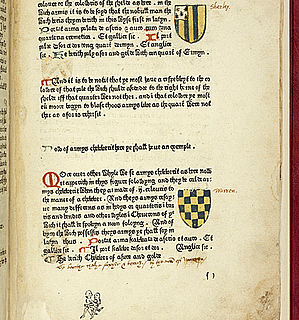 W
WThe Book of Saint Albans is the common title of a book printed in 1486 that is a compilation of matters relating to the interests of the time of a gentleman. It was the last of eight books printed by the St Albans Press in England. It is also known by titles that are more accurate, such as "The Book of Hawking, Hunting, and Blasing of Arms". The printer is sometimes called the Schoolmaster Printer. This edition credits the book, or at least the part on hunting, to Juliana Berners as there is an attribution at the end of the 1486 edition reading: "Explicit Dam Julyans Barnes in her boke of huntyng."
 W
WChronica Hungarorum is the title of several works treating the early Hungarian history.
 W
WA Catalogue of Books Printed in the Fifteenth Century now in the Bodleian Library is a short-title catalogue of more than 5,600 incunabula held in the Bodleian Library at the University of Oxford. Bod-inc. stands out among incunabula catalogues for its detailed listing of the contents of each edition being described. It was published on 7 July 2005 by Oxford University Press in six volumes.
 W
WCedid Atlas is the first translation of the atlas in the Muslim world, printed and published in 1803 in Istanbul, then the capital of the Ottoman Empire. The full title name of the atlas reads as Cedid Atlas Tercümesi and in most libraries outside Turkey, it is recorded and referenced accordingly.
 W
WThe Cetinje Octoechos is an Orthodox liturgical book printed in 1494 in Cetinje, the capital of the Principality of Zeta. It is the first incunabulum written in the Serbian recension of Church Slavonic, as well as the first book printed in Cyrillic in Southeast Europe. The octoechos was produced under the direction of Hieromonk Makarije at the Crnojević printing house, which was founded in 1493 by Đurađ Crnojević, the ruler of Zeta. Printed in two instalments, its first volume contains the hymns to be sung to the first four tones of the Octoechos system of musical modes, and the hymns for the remaining four tones are included in the second volume. The two volumes are called Octoechos of the First Tone and Octoechos of the Fifth Tone, respectively.
 W
WColumbus's letter on the first voyage is the first known document announcing the results of the first voyage of Christopher Columbus that set out in 1492 and reached the Americas. The letter was ostensibly written by Columbus himself, on February 15, 1493, aboard the caravel Niña, while still at sea, on the return leg of his voyage. A post-script was added upon his arrival in Lisbon on March 4, 1493, and it was probably from there that Columbus dispatched two copies of his letter to the Spanish court.
 W
WHermann Joseph Otto Hubert August Constantin Hupp was a German graphical artist. His main working area was heraldry, yet he also worked as a typeface designer, creating commercial symbols and metal works.
 W
WDe honesta voluptate et valetudine was the first cookbook ever printed. Written ca. 1465 by Bartolomeo Platina, it first appeared between 1470 and 1475 in Rome, and in 1475 in Venice. Written in Latin, it was largely a translation of recipes by Martino da Como from his Libro de Arte Coquinaria. The book was frequently reprinted over the next century, and translated into French, German and Italian.
 W
WDialogus creaturarum, is a collection of 122 Latin-language fables and, as the title implies, dialogues of creatures. It was the first book ever printed in Sweden (1483).
 W
WDictes and Sayings of the Philosophers is an incunabulum, or early printed book. The Middle English work is a translation, by Anthony Woodville, of an original book written in Arabic by the medieval Arab scholar al-Mubashshir ibn Fatik', titled Mukhtār al-ḥikam wa-maḥāsin al-kalim which had been translated into several languages. Woodville based his version on an earlier French translation. His translation would come to be printed by William Caxton in 1477 as either the first, or one of the earliest, books printed in the English language.
 W
WThe Epitome margaritae eloquentiae in Leeds Special Collections is the only surviving copy of a book on rhetoric written in Latin by Lorenzo Guglielmo Traversagni (c.1425-1503). The author used the pen name Guillermus Saphoensis in this work.
 W
WFasciculus Medicinae is a "bundle" of six independent and quite different medieval medical treatises. The collection, which existed only in two manuscripts, was first printed in 1491 in Latin and came out in numerous editions over the next 25 years. Johannes de Ketham, the German physician routinely associated with the Fasciculus, was neither the author nor even the original compiler but merely an owner of one of the manuscripts. The topics of the treatises cover a wide spectrum of medieval European medical knowledge and technique, including uroscopy, astrology, bloodletting, the treatment of wounds, plague, anatomical dissection, and women’s health. The book is remarkable as the first illustrated medical work to appear in print; notable illustrations include: a urine chart, a diagram of the veins for phlebotomy, a pregnant woman, Wound Man, Disease Man and Zodiac Man. In 1495, it appeared in Italian under the title Fasiculo de Medicina.
 W
WThe Gart der Gesundheit was edited in 1485. It was written by Johann Wonnecke von Kaub and it is one of the first printed herbals in German. It was often reprinted until the 18th century. The Gart der Gesundheit is an important late medieval work concerning the knowledge of natural history, especially that of medicinal plants. In 435 chapters 382 plants, 25 drugs from the animal kingdom and 28 minerals are described and illustrated. The book was edited by Peter Schöffer in Mainz. Together with the Latin Herbarius moguntinus and the Latin Hortus sanitatis, the Gart der Gesundheit belongs to the "Group of Mainz herbal incunabula."
 W
WGenealogia deorum gentilium, known in English as On the Genealogy of the Gods of the Gentiles, is a mythography or encyclopedic compilation of the tangled family relationships of the classical pantheons of Ancient Greece and Rome, written in Latin prose from 1360 onwards by the Italian author and poet Giovanni Boccaccio.
 W
WDer Gesamtkatalog der Wiegendrucke is an ongoing project of the Staatsbibliothek zu Berlin and appears in conjunction with the print edition of the union catalogue of incunabula. The Gesamtkatalog serves as a bibliography or collection of cradle prints or incunabula. The word incunabula stems from the Latin word incunabulum. In the world of books, incunabula refer to books that were printed using metal type up to the year 1500. The work is based on the description of the individual prints, each complete description consists of the bibliographic note, the collation, the description in the narrower sense, the source, and the copy. The database contains all together 36,000 descriptions of incunabula, distributed over at least 3,900 articles. The Gesamtkatalog der Wiegendrucke is available in part in print and in its entirety—in draft form—via an online database.
 W
WThe global spread of the printing press began with the invention of the printing press with movable type by Johannes Gutenberg in Mainz, Germany c. 1439. Western printing technology was adopted in all world regions by the end of the 19th century, displacing the manuscript and block printing.
 W
WFrederick Richmond Goff was an American rare book librarian and specialist in incunabula.
 W
WThe Gutenberg Bible was among the earliest major books printed using mass-produced movable metal type in Europe. It marked the start of the "Gutenberg Revolution" and the age of printed books in the West. The book is valued and revered for its high aesthetic and artistic qualities as well as its historic significance. It is an edition of the Latin Vulgate printed in the 1450s by Johannes Gutenberg in Mainz, in present-day Germany. Forty-nine copies have survived. They are thought to be among the world's most valuable books, although no complete copy has been sold since 1978. In March 1455, the future Pope Pius II wrote that he had seen pages from the Gutenberg Bible displayed in Frankfurt to promote the edition. It is not known how many copies were printed; the 1455 letter cites sources for both 158 and 180 copies. The 36-line Bible, said to be the second printed Bible, is also referred to sometimes as a Gutenberg Bible, but may be the work of another printer.
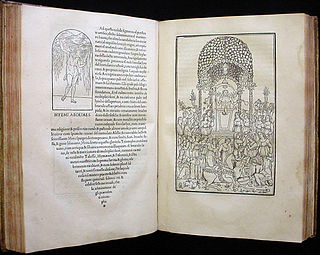 W
WHypnerotomachia Poliphili, called in English Poliphilo's Strife of Love in a Dream or The Dream of Poliphilus, is a romance said to be by Francesco Colonna. It is a famous example of an incunable. The work was first published in 1499 in Venice. This first edition has an elegant page layout, with refined woodcut illustrations in an Early Renaissance style. Hypnerotomachia Poliphili presents a mysterious arcane allegory in which the main protagonist, Poliphilo pursues his love, Polia, through a dreamlike landscape. In the end, he is reconciled with her by the "Fountain of Venus".
 W
WThe Incunabula Short Title Catalogue (ISTC) is an electronic bibliographic database maintained by the British Library which seeks to catalogue all known incunabula. The database lists books by individual editions, recording standard bibliographic details for each edition as well as giving a brief census of known copies, organised by location. It currently holds records of over 30,000 editions.
 W
WThe Llibre de les Dones is a book that was possibly written between 1387 and 1392 by Francesc Eiximenis in Catalan in Valencia and dedicated to Sanxa Ximenes d'Arenós, countess of Prades.
 W
WThe Llibre dels àngels is a literary work that was written by Francesc Eiximenis in 1392 in Valencia in Catalan. It was dedicated to Pere d'Artés, who was a kind of Chancellor of the Exchequer of the Crown of Aragon, and who was a close friend of him. It has two hundred and one chapters, and it is divided into five treatises.
 W
WLo Crestià was an encyclopaedia written in Catalan, that was sponsored by the king Peter IV of Aragon and written by Francesc Eiximenis between 1379 and 1392. The first book and the half of the twelfth one were printed by the German printer Lambert Palmart in Valencia in 1483 and 1484.
 W
WThe Lyme Caxton Missal is an incunable or early printed book containing the liturgy of the Mass according to the Sarum Rite, published in 1487 by William Caxton. The copy at Lyme Park, Cheshire, England, is the only nearly complete surviving copy of its earliest known edition. It is held in the library of the house and is on display to visitors.
 W
WThe Mainz Psalter was the second major book printed with movable type in the West; the first was the Gutenberg Bible. It is a psalter commissioned by the Mainz archbishop in 1457. The Psalter introduced several innovations: it was the first book to feature a printed date of publication, a printed colophon, two sizes of type, printed decorative initials, and the first to be printed in three colours. The colophon also contains the first example of a printer's mark. It was the first important publication issued by Johann Fust and Peter Schoeffer following their split from Johannes Gutenberg.
 W
WMissale Aboense was the first book printed for Finland. As its name suggests, it was a prayer book used for Mass. It follows the tradition of the Dominican liturgy, which around the year 1330 was adopted as the official liturgy of the see of Turku. This poor bishopric could not afford to have its own missal printed, but its Dominican tradition came to the rescue.
 W
WMissale Romanum Glagolitice is a Croatian missal and incunabulum printed in 1483. It is written in Glagolitic script and is the first printed Croatian book. It is the first missal in Europe not published in Latin script. Its editio princeps, unique in the achieved typographic artistry, was published only 28 years after the Gutenberg bible's 42-lines, bears witness of high cultural attainment and maturity of Croatian Glagolites and Croatian mediaeval literature.
 W
WAbu al-Wafa' al-Mubashshir ibn Fatik was an Arab philosopher and scholar well versed in the mathematical sciences and also wrote on logic and medicine. He was born in Damascus but lived mainly in Egypt during the 11th century Fatimid Caliphate. He also wrote an historical chronicle of the reign of al-Mustansir Billah. However, the book he is famed for and the only one extant, Kitāb mukhtār al-ḥikam wa-maḥāsin al-kalim, the "Selected Maxims and Aphorisms", is a collection of sayings attributed to the ancient sages translated into Arabic. The date of composition given by the author is 1048–1049.
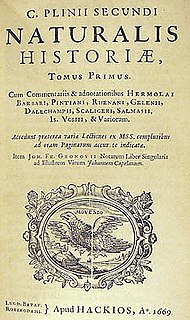 W
WThe Natural History is a work by Pliny the Elder. It is one of the largest single works to have survived from the Roman Empire to the modern day and purports to cover all ancient knowledge. The work's subject area is thus not limited to what is today understood by natural history; Pliny himself defines his scope as "the natural world, or life". It is encyclopedic in scope, but its structure is not like that of a modern encyclopedia. It is the only work by Pliny to have survived, and the last that he published. He published the first 10 books in AD 77, but had not made a final revision of the remainder at the time of his death during the AD 79 eruption of Vesuvius. The rest was published posthumously by Pliny's nephew, Pliny the Younger.
 W
WThe Nuremberg Chronicle is an illustrated encyclopedia consisting of world historical accounts, as well as accounts told through biblical paraphrase. Subjects include human history in relation to the bible, illustrated mythological creatures, and the histories of important Christian and secular cities from antiquity. Finished in 1493 after years in the making, it was originally written in Latin by Hartmann Schedel, and a German version was translated by Georg Alt. It is one of the best-documented early printed books—an incunabulum—and one of the first to successfully integrate illustrations and text.
 W
WThe Pastorale (Pastoral) is a literary work that was written by Francesc Eiximenis in Valencia in Latin between 1397 and 1400. It was dedicated to the bishop of Valencia Hug de Llupià.
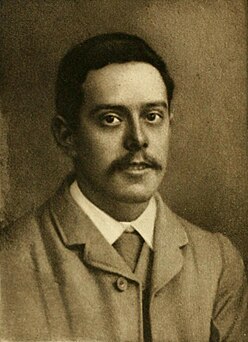 W
WRobert George Collier Proctor was an English bibliographer, librarian, book collector, and expert on incunabula and early typography.
 W
WThe Psalterium alias laudatorium is a literary work that was written by Francesc Eiximenis in Latin between 1404 and 1408 in Valencia. It consists of a collection of prayers, and was dedicated to the Pope of Avignon Benedict XIII.
 W
WThe Regiment de la Cosa Pública is a work that has 38 chapters and that was written in Catalan by Francesc Eiximenis in 1383. It was just written after Eiximenis' arrival in Valencia, and it was dedicated to the jurats.
 W
WThe book that is known as Scala Dei, also called Tractat de contemplació is a literary work written by Francesc Eiximenis possibly in 1399 in Valencia in Catalan and dedicated to Maria de Luna, queen of the Crown of Aragon and wife of king Martin of Aragon.
 W
WThe Sibyllenbuch fragment is a partial book leaf which may be the earliest surviving remnant of any European book that was printed using movable type. The Sibyllenbuch, or Book of the Sibyls, was a medieval poem which held prophecies concerning the fate of the Holy Roman Empire.
 W
WThe Speculum Humanae Salvationis or Mirror of Human Salvation was a bestselling anonymous illustrated work of popular theology in the late Middle Ages, part of the genre of encyclopedic speculum literature, in this case concentrating on the medieval theory of typology, whereby the events of the Old Testament prefigured, or foretold, the events of the New Testament. The original version is in rhyming Latin verse, and contains a series of New Testament events each with three Old Testament ones that prefigure it. It is one of the most common books found as an illuminated manuscript, and also in early printing in both blockbook and incunabulum forms.
 W
WSpovid općena is the name of the first Croatian language printed book from 1496. It was printed in the printing press of Senj, Croatia and its process was overseen by Blaž Baromić. It was published some thirteen years after the first Croatian printed book Missale Romanum Glagolitice, written in Old Church Slavonic. It contains 36 leaves, and is also the first Croatian non-liturgical incunabula. The book is a translation of "Confessione generale" by the Milanese author Michele Carcano. The translation work was done by Jakov Blažiolović. The opening lines are "Počine spovidь opĉena ča est načinь ki ima držati č[lovi]kь naispita ñe konšencie kad se oĉe ispovid[a]ti".
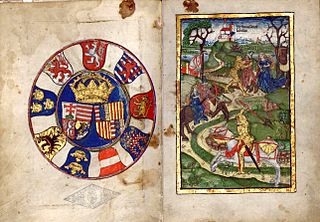 W
WJohannes de Thurocz, was a Hungarian historian and the author of the Latin Chronica Hungarorum, the most extensive 15th-century work on Hungary, and the first chronicle of Hungary written by a layman.
 W
WTirant lo Blanch is a chivalric romance written by the Valencian knight Joanot Martorell, finished posthumously by his friend Martí Joan de Galba and published in the city of Valencia in 1490 as an incunabulum edition. The title means "Tirant the White" and is the name of the romance's main character who saves the Byzantine Empire.
 W
WThe Valencian Bible was the first printed Bible in the Catalan language. It was first printed between 1477 and 1478. It is the third Bible printed in a modern language. The first printed Bible was the Latin Bible, Vulgate version, printed at Mainz in 1455.
 W
WThe Vida de Jesucrist is a literary work by Francesc Eiximenis in Catalan written in Valencia possibly between 1399 and 1406, though the important scholar Albert Hauf dates it to 23 June 1403.. It was dedicated to Pere d'Artés, who was a kind of Chancellor of the Exchequer of the Crown of Aragon, whom Eiximenis had already dedicated the Llibre dels àngels.